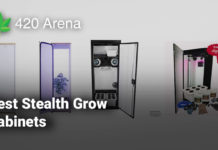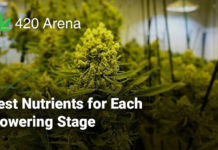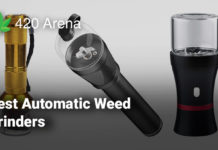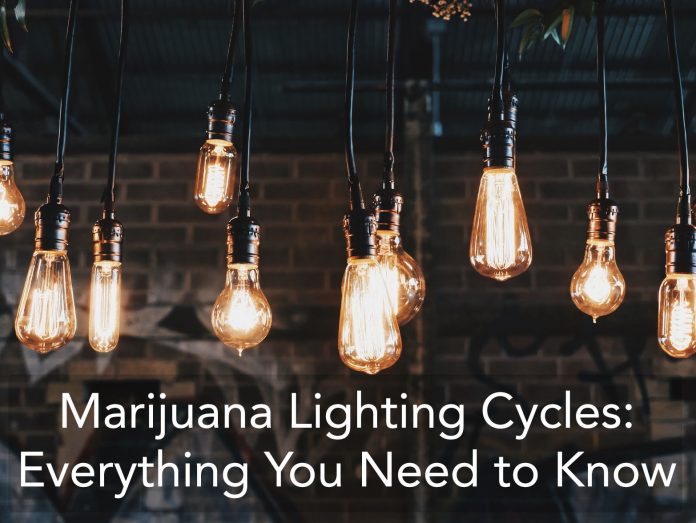Many people talk about using grow lights for marijuana plants. However, they may not understand how to use those lights. Lighting is a complicated topic. Because marijuana is photosensitive, the grow lights and your lighting cycle strategy influences the plants’ growth, development, and yield.
If you’re growing marijuana indoors, you can control those cycles. But what do you do if you’re growing outdoors? We’ll discuss ways to manage marijuana lighting cycles in any environment and explain what to do when your plants are at the mercy of the sun’s rays.
Light Receptors and Plant Growth
When you’re young, you learn that plants need sunlight to grow. While that’s true, cannabis requires short days and long nights to flower. However, the cannabis light cycle is complex.
Cannabis plants contain photoreceptors. Phytochrome red and phytochrome far-red photoreceptors absorb light with specific wavelengths that fall on the red end of the spectrum. They also regulate flowering. If the plant has too many phytochrome far-red receptors, it won’t flower.
A marijuana plant develops the receptors to match the type of light that it’s exposed to. Therefore, if you use a light with far-red wavelengths, you’ll generate a plant with phytochrome far-red receptors.
When your plant is exposed to plenty of light, it contains equal numbers of far-red and red receptors. As the days grow shorter, phytochrome far-red receptors gradually transform into phytochrome red receptors. When the plant contains fewer far-red receptors, it begins flowering.
At this point, you don’t want to use any far-red lights. Doing so will convert the phytochrome red receptors back into far-red receptors. Therefore, you don’t want to interrupt the long periods of darkness.
Light Affects the Chemical Composition of the Plant
The type of light that you use for growing cannabis makes a difference. Cannabinoids are the active compounds that are found in the cannabis plant. THC might be the most well-known. It’s the component that produces psychoactive effects.
However, approximately 66 other chemicals in the plants are considered to be cannabinoids. Exposure to different light spectrums doesn’t seem to influence the total number of cannabinoids in the plant. But it can change the ratios of the various chemicals.
This is important because many of these chemicals have healing properties. You can grow a plant with large, abundant flowers. But many growers want to ensure that their yield contains certain levels of specific cannabinoids. For example, using a high pressure sodium vapor light instead of LED lighting may produce plants with lower THC levels.
Understanding Light and the Vegetative Stage
Marijuana plants do need plenty of light while they’re in the vegetative stage. They must form a strong root structure to support the plant’s future growth. Foliage develops before flowers do. The green leaves soak up the sun and convert it to sugar, which fuels the plant.
The chemical reactions that happen during the vegetative stage rely on chlorophyll receptors. These receptors absorb blue and red light. The grow lights that you use at this time should cover the whole spectrum and be similar to sunlight.
During the vegetative stage, if the light source is too far away from the plants or you don’t use a full-spectrum light, the vegetation will stretch. This is a shade-avoidance response that can make your harvest less than desirable. Also, research shows that exposing plants to red and blue light can restrict the leaf size.
Therefore, you should use full-spectrum lights during the vegetative stage. The lights that you choose for this growing stage should have at least 12 percent blue wavelengths.
Metal halide grow lights have a strong tendency toward blue wavelengths. Many growers use LED lights, which are full-spectrum options that are suitable for the plant’s entire life cycle.
Use the lights for at least 14 hours a day during the vegetative stage. The plants don’t need more darkness until they’re ready to flower, which we’ll discuss below. Many growers choose to light their plants for up to 24 hours during the vegetative stage.
Still, some rest time won’t hurt. Turning off the lights for up to about six hours a day can save power and money. However, keeping the lights on for longer will help the plant grow faster. It can also improve the size of the buds when they form during the flowering stage.
Just make sure that you don’t keep grow lights on seedlings for 24 hours a day. Doing this can burn them. Plants can accommodate additional light as they get older and more mature.
The vegetative stage lasts for as long as you’d like it to. There are different ideal times for various strains. Plus, some strains grow taller or produce better yields than others. If you have enough space, keeping your plants in the vegetative stage for at least 60 days will give them the best chance of growing the most flower.
As you’ll learn below, however, give your plants additional space to grow during the flowering stage. They can increase their height by two or three times after the vegetative phase.
If you grow indoors, you can completely control the amount of light that you give your plants. Growing weed outside poses some challenges, which we explain in more detail later in this article.
Understanding How Weed Flowers
Marijuana plants that are grown outdoors typically move into the flowering stage toward the end of the summer. They flower until the fall. You might think that this shift in the life cycle occurs because of the change in temperature. However, the plants are actually affected by the changes in light and dark during the day.
As the days grow shorter and the nights get longer, marijuana plants receive the signal to start flowering. This usually happens when the plants get 10 to 12 hours of darkness within a 24-hour period. Once the plants shift into the flowering cycle, they put less energy into growing taller and producing leaves.
The flowering cycle depends on the plant and strain. Most marijuana plants flower for seven to nine weeks. However, some sativas take longer to develop mature buds.
During the first week of the flowering stage, the plants begin to transition. They continue to grow taller, almost doubling in height. The plant also grows new leaves and stems so that it’s sturdy enough to support the flowers that are about to begin developing.
Low-stress training, or LST, is a technique that you can use to manipulate the shape of the plant growth. Most marijuana plants have a tendency to grow like Christmas trees. They develop an elongated cola on the main stem and smaller buds on the side branches.
LST allows you to make better use of your lighting. It requires you to bend the branches down and away from the center of the plant. This makes the height of the canopy more even so that the plant can take advantage of the light distribution.
During the second week of flowering, female plants will begin to grow white, hair-like protrusions. These will eventually become buds. At this point, you might want to use flowering nutrients to produce the best yield.
Buds will develop where the white hairs were during week three. Now, your plant is devoting less energy to vegetative growth and more to the flowers. It’s critical that you provide the right nutrients during this time.
By week four, the plants stop growing taller. The buds become larger. During this time, the plant produces more odor. If you used the LTS technique to alter the growth of your plant, you can stop doing that now. Some branches might need additional support to hold up the weight of the flowers.
Around week five, the plants will be in full flowering mode. The buds will become plentiful and fat. As the white hairs turn darker, the plant indicates that it is almost ready for harvest.
Most strains can be harvested between weeks six and eight. When the trichomes become amber and opaque, the THC content has reached its peak, and you can start the harvest.
Manipulating the Light for Indoor Growing
Marijuana plants need plenty of light and very little darkness until they reach the flowering stage. The following chart explains the amount of light that you should provide for the various growth stages:
• Seed germination – 18 hours of light for 5 to 10 days
• Seedlings – 18 hours of light for 2 to 3 weeks
• Vegetative stage – 18 hours of light for 3 to 16 weeks
• Flowering stage – 12 hours of light for 8 to 11 weeks
When you’re growing weed indoors, you have to manipulate the light to help the plants reach their full potential. You can use lighting to mimic the natural change of the seasons. However, you can also adapt the lighting to encourage the weed light cycle to move more quickly. For example, adding more hours of darkness will force the plants to flower sooner than they might have otherwise.
No matter what, you will need to change the marijuana lighting cycles if you want to encourage the plant to flower at all. Switching to a 12/12 schedule will cause the flowering cycle to begin.
You can also jump-start the flowering stage by giving your plants 36 hours of consistent darkness. This reduces the levels of phytochrome far-red significantly. Your plants will begin the flowering process, and you can switch to a 12/12 schedule after the 36 hours.
It’s essential that the periods of darkness are uninterrupted. If you open a door and allow light into the room for a second, you’ll alter the plants’ growth. You can ensure constant darkness by making sure that no light leaks into the grow room.
To do this, turn off all of the lights, and enter the room. Allow your eyes to adjust to the darkness. This may take up to 30 minutes. Then, hold your hand in front of your face. If you can see it, light is entering from somewhere.
Check for areas of light that may seep in. Look under doors, around windows and on electronic equipment. Cover the lights on this type of equipment with duct tape.
When you do use grow lights during the flowering stage, remember that the plants should get some red light at this point. Full-spectrum LED lights are still appropriate. Flowering cannabis plants need more red than blue wavelengths.
Can You Control the Marijuana Lighting Cycles Outdoors?
Many people choose to grow outdoors for a number of reasons. There’s more space outside, and you don’t have to spend money on grow lights. However, it’s harder to control the amount of light that your plants get.
If you’re growing and harvesting based on the natural change of seasons, you might want to start your seedlings indoors. Move them outside when the danger of frost has subsided. Allow them to develop vegetation throughout the summer. As the days begin to grow shorter, the plants will begin to flower.
You might want to achieve an early harvest or collect buds more than once a year, though. In those cases, you’ll need to deprive the plants of light.
Covered gardens are ideal for outdoor grow settings. A blackout tent can trick your plants into thinking the sun has gone down. It also blocks the ambient light that can impair your yield during the nighttime.
You can also build a simple frame and cover it with a tarp. Light deprivation techniques are dependent on the size and number of plants. Make sure that your plants can still breathe under the blackout tent or tarp. Inadequate ventilation can lead to mold and moisture problems.
Cover the plants at night so that they receive 12 hours of darkness. Uncover them in the morning, about 12 hours before sunset.
When you use the light deprivation technique to grow plants outdoors, you can schedule your first harvest to fall between May and July. Your second harvest will occur in the fall. You’ll be able to take advantage of the bright July sunlight to help the buds from your initial harvest fatten up. The strong UV rays promote flower growth and help combat moisture problems.
To use the light deprivation technique on your outdoor plants for two harvests a year, follow the steps below:
• Use fluorescent lighting to start your seedlings indoors in the spring.
• Move the plants outside between April and May, when the chance of frost is over.
• As soon as you put the plants outdoors, cover them for 12 hours a night with a blackout tent.
• Start the next batch of seedlings inside when the first batch begins to flower.
• Harvest the first batch around mid-summer.
• Plant the second batch outside in late July.
• You don’t have to deprive the second batch of light because it will flower as the days grow shorter. However, you might want to start the light deprivation technique early so that you can harvest the plants before the first fall frost.
If you put your plants outside in the fall, they’ll probably start flowering right away. To keep them in the vegetative state for as long as possible, make sure that they get about 18 hours of light. You can keep a small light on near the plants when it gets dark. Only a few leaves on each plant need light exposure to remain in the vegetative phase.
Some growers use the Gas lantern routine. To do this, turn on a light for one to three hours during the dark period. You can use a household bulb. Just make sure that it reaches all of the plants in your garden.
The Bottom Line
It’s vital that your cannabis plants get plenty of sunlight while they’re in the vegetative state. If you want them to flower, you must provide them with 12 hours of uninterrupted darkness each day.
Growing indoors typically produces the most stable lighting conditions. However, you might have more space and flexibility if you grow outdoors. Taking advantage of natural sunlight can also save you money and energy. If you grow outdoors, make sure that you pay attention to the marijuana lighting cycles so that you can maximize your yield.
Table of Contents

















![How to Use Carbon Filters in Your Grow Room [7 Best Carbon Filters for Grow Rooms in 2021] How to Use Carbon Filters in Your Grow Room](https://420arena.com/wp-content/uploads/2020/12/How-to-Use-Carbon-Filters-in-Your-Grow-Room-218x150.jpg)










